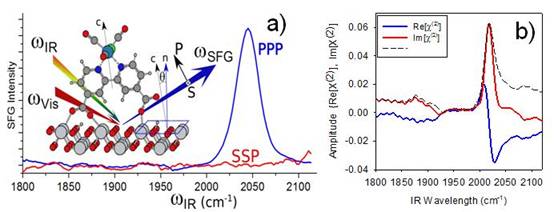www.acsprf.org
Reports: ND649286-ND6: Vibrational Sum-Frequency Probe of Interfacial Electron Transfer Dynamics
Tianquan Tim Lian , Emory University
Understanding interfacial structural and dynamics (such as energy and charge transfer) at molecular adsorbate /semiconductor interface is essential to many important applications, such as solar cells, photocatalysis, and molecular electronics. To enable quantitative comparisons with theoretical studies, we have developed vibrational sum-frequency-generation (VSFG) as a time-dependent probe for studying structure and dynamics of molecules on well-characterized single crystal surfaces. In the second year of this research project, we have completed a study of the adsorption geometry of ReL0Cl(CO)3 [L0=4,4'-bipyridine-2,2'-COOH, or ReC0A] on the (001) rutile TiO2 single crystal surface. By comparing experimentally measured orientation angle between the molecular axis c and the surface normal (see Figure 1a) and the computed surface structures, we were able to determine the binding modes of this molecule at the interface, demonstrating the ability for such combined experimental (SFG) and computational techniques for studying interfacial structure.1 To use VSFG as a dynamic probe (in a pump/probe experiment), significant improvement in the signal-to-noise ratio is needed. To this end, we have improved the SFG S/N ratio by implementing heterodyne detection. Furthermore, this enable the separation of the real and imaginary part of the second order susceptibility (shown in Figure 1b), which will facilitate the assignment of pump/probe signal changes. We are now using this technique to study interfacial dynamics induced by a visible or IR pulse excitation.
Figure 1. a) Homodyne and b) heterodyne detected SFG spectra of ReC0A on (001) surface of rutile TiO2 single crystal. Also shown in a) is a polarization dependence of the SFG signal as well as computed interfacial structure of ReC0A.
Reference. 1) Anfuso, C. L.; Snoeberger, R. C., III; Ricks, A. M.; Liu, W.; Xiao, D.; Batista, V. S.; Lian, T. Covalent Attachment of a Rhenium Bipyridyl CO2 Reduction Catalyst to Rutile TiO2. J. Am. Chem. Soc. (2011), 133, 6922-6925.

